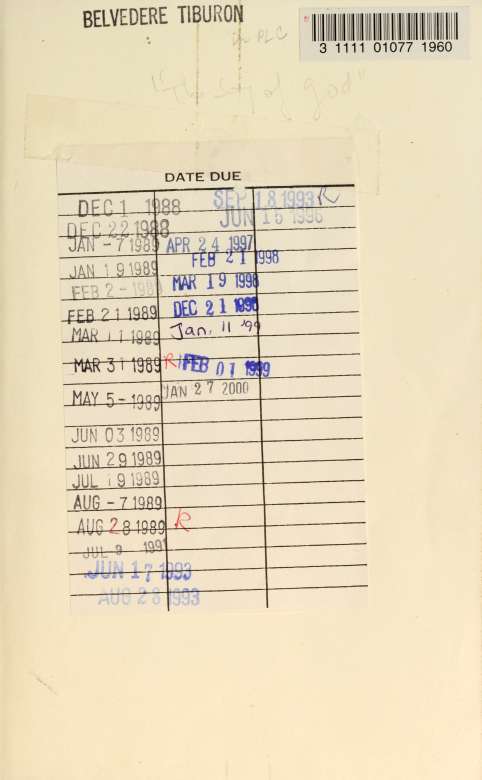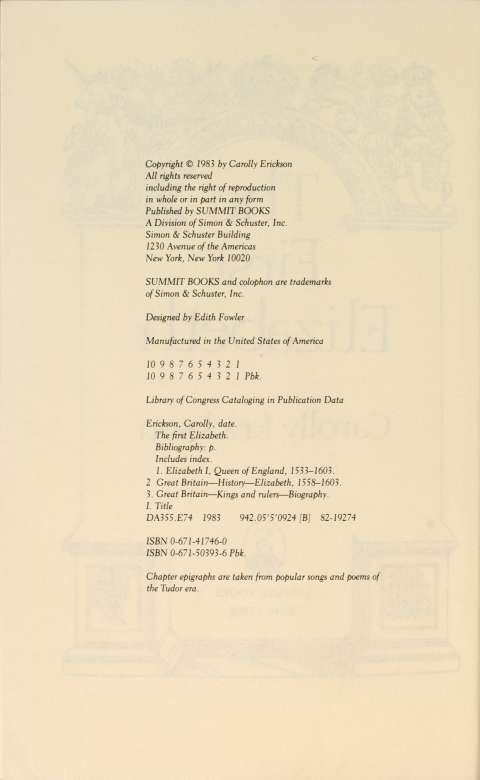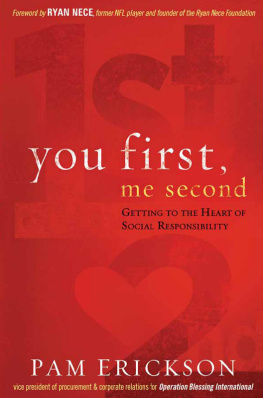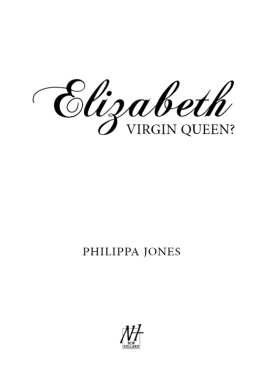Erickson - The first Elizabeth
Here you can read online Erickson - The first Elizabeth full text of the book (entire story) in english for free. Download pdf and epub, get meaning, cover and reviews about this ebook. year: 1983, publisher: New York : Summit Books, genre: Non-fiction. Description of the work, (preface) as well as reviews are available. Best literature library LitArk.com created for fans of good reading and offers a wide selection of genres:
Romance novel
Science fiction
Adventure
Detective
Science
History
Home and family
Prose
Art
Politics
Computer
Non-fiction
Religion
Business
Children
Humor
Choose a favorite category and find really read worthwhile books. Enjoy immersion in the world of imagination, feel the emotions of the characters or learn something new for yourself, make an fascinating discovery.
- Book:The first Elizabeth
- Author:
- Publisher:New York : Summit Books
- Genre:
- Year:1983
- Rating:4 / 5
- Favourites:Add to favourites
- Your mark:
- 80
- 1
- 2
- 3
- 4
- 5
The first Elizabeth: summary, description and annotation
We offer to read an annotation, description, summary or preface (depends on what the author of the book "The first Elizabeth" wrote himself). If you haven't found the necessary information about the book — write in the comments, we will try to find it.
The first Elizabeth — read online for free the complete book (whole text) full work
Below is the text of the book, divided by pages. System saving the place of the last page read, allows you to conveniently read the book "The first Elizabeth" online for free, without having to search again every time where you left off. Put a bookmark, and you can go to the page where you finished reading at any time.
Font size:
Interval:
Bookmark:

This book made available by the Internet Archive.








PART ONE
The Improbable Child

The people flocked there amain The multitude was great to see; Their joyful harts were glad, and fain To view her princely maiesty, Who at length came riding by, Within her chariot openly; Even with a noble princely train Of lords and ladies of great fame.
T
JLh<
he afternoon sun was already low as the constables and marshals, their great staves ready in their hands, took up their stations along the route the royal procession would follow. They wore liveries of velvet and silk, in keeping with the pomp of the occasion, but their function would be more than ceremonial this day. The crowds that had gathered to watch the spectacle had begun to bank up behind the railings erected along one side of the route, and threatened to spill out into the path of the marchers. It was a noisy, restless crowd, sullen rather than welcoming, and the men deputed to keep order set their faces in a stern rictus and gripped their staves more tightly as the sound of hoofbeats in the distance signaled the beginning of the parade.
Anne Boleyn, wife of King Henry VIII, was to ride in ceremony on this May afternoon in 1533 through the City of London and then westward along the Strand to Westminster, where next day she would be crowned queen of England. The route of march was set by time-honored tradition: from the Tower of London the queen and her attendants would process by Gracechurch Street and Cornhill to St. Paul's, pausing frequently to enjoy the singing and pageantry prepared in Anne's honor, and then along Fleet Street to Temple Bar and so into the Strand. The houses and shops lining these streets were decorated with tapestries and silken hangings, and from
their upper windows ladies and gentlewomen who had not been summoned to ride with the queen looked out expectantly, watching for the first of the riders to come into view.
As the procession snaked its way through the narrow streets tradition called for the onlookers to kneel and take off their caps when the royal litter passed, and to give a lusty cry of "God save the queen!" But few such greetings were heard. Instead there were rough snickers and laughter, or silent glares and frowns of disapproval or, when the constables and marshals were out of earshot, insults and curses.
Women jostled one another and rolled their eyes, nodding to indicate the slack lacing of the queen's white satin kirtle. They noted the elegance of her gown, cut in the French fashion and furred with ermine, but they paid more attention to her swollen belly, and to the odd bulge at her neck and the marks of scrofula that, in their eyes, disfigured her beauty and made her monstrous.
Children squinted to look hard at her hands, trying to catch a glimpse of the freak sixth finger which, they heard their parents say, was the sure mark of a witch. And men stared at her, some quizzically, some in censure, curious to see at close range the notorious woman who had caused the great scandal only to be touched despite themselves by the allure of her features and expression.
Through it all Queen Anne rode unabashed, regal, triumphant. She paid little heed to the jeers and mockery around her, and none at all to the appraising stares directed at her person. She carried her head proudly, not only to keep in place the jeweled circlet she wore but from habit, for she had a long and graceful neck and knew how to show it to advantage. She was at her best that day, her color high from excitement and her cheeks rosy in the cool spring air. The contours of her oval face had rounded noticeably in recent weeks, and now that she was in the sixth month of pregnancy her morning sickness was past and she felt as well as she ever had in her life. She sat back against the gold cushions of her litter, aware of the sensation she was creating, aware of the attractive picture she made in her satins and shining jewels, her silhouette framed by the thick black hair that fell in waves to her waist.
What if her subjects mocked her? What if they called her Concubine, Whore, the Scandal of Christendom? She had borne their taunts for years. This day, this procession was her revenge. Today all the leading nobles and gentlewomen of the kingdomincluding many who were her bitter enemieswere escorting Anne to the site of her coronation. Tomorrow at the coronation itself they would attend her, kneeling reverently before her to swear fealty. Only her haughty uncle the duke of Norfolk was absent
pardonably, as he was on a diplomatic mission in France. Norfolk's wife, however, had flatly refused to ride in the procession, though his stepmother, the aging dowager duchess, rode conspicuously beside Anne's mother in a handsome chariot; tomorrow she would have the honor of carrying Anne's train.
Yet sweet as it was, the crown was not Anne's ultimate triumph. Her child, the male heir the astrologers so confidently predicted: he was her final vindication.
He had been the real objective from the beginning, from the time seven years before when the king, Henry VIII, first began to woo her. All along the king had needed, had wanted a son to succeed him. And Anne, once she realized that her destiny was to be bound up with the king's, had been determined to bear his sonnot a bastard, born in secret like Henry's son by his mistress Bessie Blount, but a legitimate scion of the Tudor line, born in a royal bed, christened true heir to the throne.
For all these years, through all the stumbling blocks and confusions of the king's infamous divorce from his formidable first wife Katherine of Aragon, Anne had held firm to her purpose. She would wait to have her son until she could be queen, until he could be prince of Wales.
Then last fall the waiting ended. The king had taken her to Calais, not as his mistress but as marquess of Pembroke, a great lady with a man's title (for she held it in her own right) and a queenly entourage. At Calais she had been provided with everything a queen could desire, new fur-trimmed silken gowns, her favorite foodsgrapes and pears specially imported, porpoises and pasties of red deereven the jewels of a queen. (These Anne's rival, Henry's wife Katherine, had at first refused to provide, saying it went against her conscience to lend her jewels to adorn a woman of ill repute, but in the end she had yielded.)
Everyone, including Katherine, had been convinced that the king would marry Anne in Calais, during his days of banqueting and jousting with the French king, far from the angry crowds that would have been certain to protest the marriage in England. But Anne's closest confidants knew otherwise. She had reportedly told one of them that even if King Henry wished it she would refuse to marry him in Calais, wanting the ceremony to take place in England, "where queens are wont to be married and crowned." 1
Font size:
Interval:
Bookmark:
Similar books «The first Elizabeth»
Look at similar books to The first Elizabeth. We have selected literature similar in name and meaning in the hope of providing readers with more options to find new, interesting, not yet read works.
Discussion, reviews of the book The first Elizabeth and just readers' own opinions. Leave your comments, write what you think about the work, its meaning or the main characters. Specify what exactly you liked and what you didn't like, and why you think so.

















